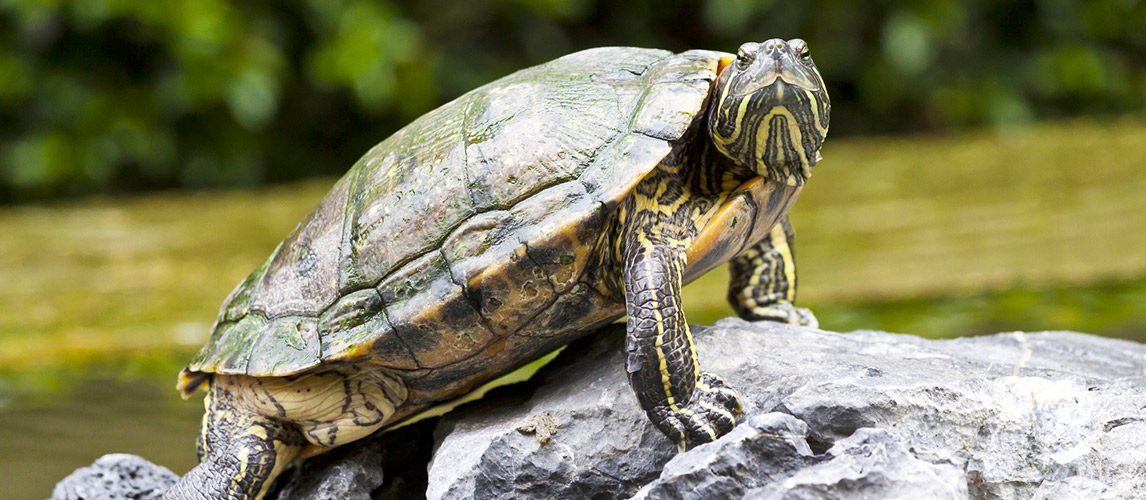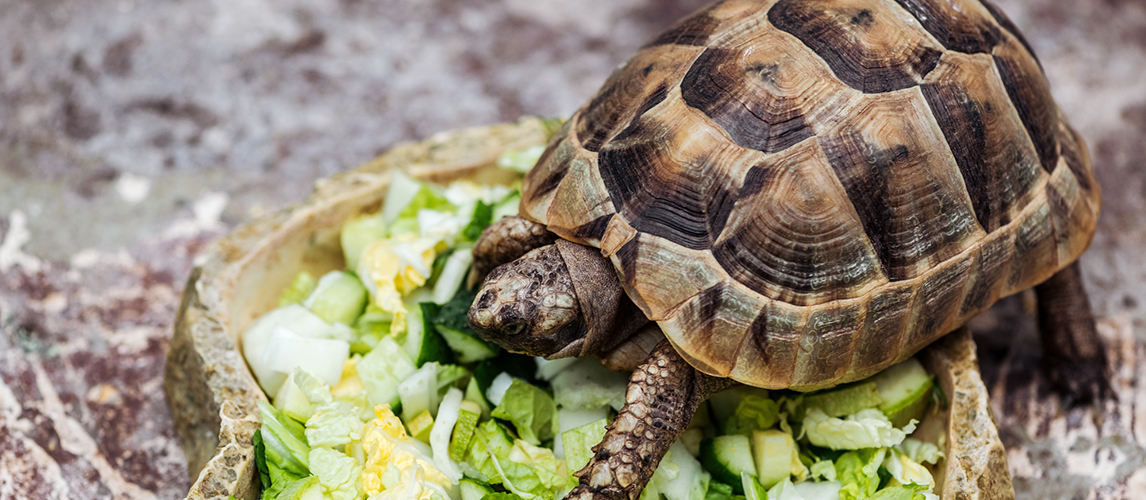Red-Eared Sliders (Trachemys Scripta Elegans, as they’re known scientifically) need a lot of care and attention over the 20 years of their lifespan. They’re certainly a commitment, which some pet owners aren’t fully prepared for before they start looking to adopt one of these turtle breeds. Anyone looking to keep a Red-Eared Slider as a pet should be sure to gather a variety of information about caring for these pet turtles.
About The Red-Eared Slider
The Red-Eared Slider is a semiaquatic turtle that belongs to the Emydidae family. This set of turtles carry a more common name: Terrapins. They are almost entirely based in the Western Hemisphere. Just two species of turtle in this family tree are based in the East.
Red-Eared Sliders are the most popular pet turtle to own in the U.S., despite the restrictions that prohibit people from owning turtles that are smaller than four inches. This particular species is also categorized as invasive, which led to it being one of the most commonly traded species of turtle across the world’s pet trade.
If you’re wondering how invasive a species of turtle can truly be, Red-Eared Sliders are on the top 100 list for the world’s most invasive species, which is published by the International Union for the Conservation of Nature.
Alternative names:
- Slider Turtle
- Water Slider Turtle
- Red-Eared Turtle
- Red-Eared Terrapin
- Red-Eared Slider Turtle
- Trachemys Scripta Elegans
Did you know that the Red-Eared Slider gets its name from a tiny red stripe around the area where its ears would be? The second part of their name comes from their capability to quickly slide off of rocks and into nearby water.
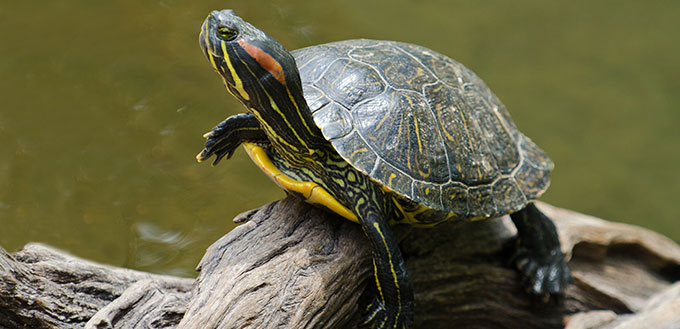
Red-Eared Slider Size
The average length of a Red-Eared Slider’s shell is 6 to 8 inches, which is what helps them bypass the American regulation that controls their sale and distribution. Some Red-Eared Sliders have been known to have a carapace length of up to 16 inches, and it’s not unusual for the females of the species to grow to the size of a dinner plate. Pet owners often associate terrapins with the image of a tiny turtle, but your Red-Eared terrapin may very well grow bigger than you expect.
Red-Eared Slider Appearance
Adult Red-Eared Sliders can be identified by their dark brown or olive-colored top shell that will have a yellow pattern on the belly of the shell. You should also be on the lookout for the prominent red or maroon stripe around where the turtle would have its ears; this is a huge giveaway for the Red-Eared Slider breed.
Sliders have strong beaks that look jagged up-close, and their bodies are often covered in a variety of long, pale yellow markings. The female of the species is larger than the male, with a stubby length of tail and shorter claws.
Red-Eared Slider Behavior
Mating for this subspecies happens between March and June each year after the individual adult turtles have reached their sexual maturity. For males, that happens between 2 to 3 years old, while females mature between 5 and 7 years old. A clutch of Slider eggs can contain anywhere from 5 to 20 eggs per clutch, and female Sliders can lay up to three clutches during each mating season.
Newly hatched Sliders dig their own way out of the nest that their mother secured them in. The small hatchling reptiles will then be challenged to immediately find food and water to survive. Unfortunately, many babies do not make it.
Sliders are reptiles that we associate with the wild and the sea. We often picture them diving deep into the ocean or walking slowly across the shore. A Red-Eared Slider who is kept in housing as a pet may exhibit a lot of behavior that the typical pet-owning household isn’t used to.
Expect these reptiles to bask in the warmth and light of their tank, slide from rocks into the water to go for a swim, and just sit still for long periods of time. None of these behaviors are abnormal for pet turtles.
Concerning Behaviors
If your pet Sliders are refusing to bask outside of the water in their tank or they are fluttering their claws, then their well-being may be at risk. Though Sliders usually flutter their claws during mating, they also do it to establish dominance and will perform the same movements in a show of territorial behavior. Attached to that same movement may come the turtle’s need to snap at you.
These are all signs that your Slider is uncomfortable or frustrated about something that has changed in their habitat.
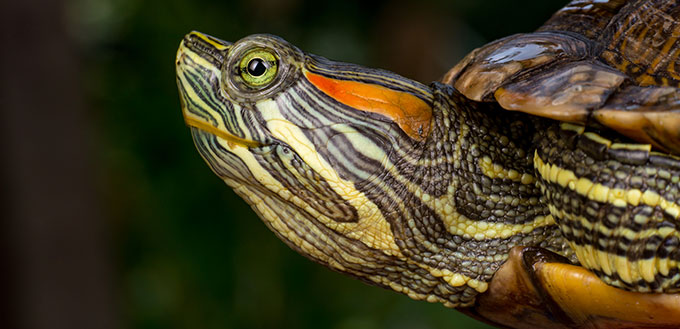
Red-Eared Slider Habitat
The Slider turtle is native to Southern America and the north of Mexico. They would have first appeared around the Gulf of Mexico and the Mississippi River, as well as other warm southern climates in the United States. Expect to also find a lot of these subspecies in these areas:
- New Mexico
- South Carolina
- Virginia
- Florida
- Kentucky
- The Virgin Islands
The habitat of a wild Slider consists of wetlands, rivers, and other freshwater locations. They enjoy calm water and will use rocks or logs to bask in the sun.
Indoor Habitats
Terrariums are the best indoor housing for Red-Eared Sliders because you can control the size, the water quality, and personalize the tank to meet the needs of any animals that you house in one. Water changes in a terrarium are also something that you have control over and can correct when they occur. Red-Eared Sliders prefer water to be around 72 to 77 degrees Fahrenheit.
For a single Red-Eared Slider, consider buying a tank that can hold at least 50 gallons of water. This is the bare minimum that you should give your new friend. They’ll use the water to swim around, bask, and get in some exercise. Once you find a big enough tank, you’ll need a good heat lamp and a basking platform next to that lamp so that they have a basking site.
What do Red-Eared Sliders Turtles Eat?
Turtle pellets are the perfect staple food for the Red-Eared Slider diet and they are readily available in pet stores. This subspecies of turtle enjoys aquatic plants (such as water lettuce), leafy vegetables, squash, and carrots in their diet.
You can also feed them freeze-dried krill as an occasional part of their diet – a treat, not a regular feeding. Other treats can include earthworms and comet goldfish. The diet of a Red-Eared Slider is simple and inexpensive.
Red-Eared Slider Care
Red-Eared Sliders have a life expectancy that is anywhere from 20 to 30 years. Healthy Red-Eared Sliders may be blessed with slightly longer life and the occasional individual turtle of this breed has lived more than 40 years.
Keep their tank clean, check the water temperature often, and feed them vegetables no more than three times a week (alongside their other food). Make sure your cold-blooded Slider has room to bask in the warmth of their lamp so they can regulate their body temperature.
Take special care of your Slider in the winter months because abrupt water temperature changes can kill any species of turtle. We recommend a temperature monitor to help with this – you can buy easy-to-read ones that stick to the outside of a tank.
Common Health Problems
When you buy a Slider from a pet store, there’s no guarantee that your new turtle friend is going to be completely healthy. Only purchase or adopt terrapins from a reputable store or licensed individual and be sure to get as much information as you can before you buy.
Red-Eared Sliders do have a handful of common health problems that may occur over their lifetime. These include:
- Eye infections
- Intestinal parasites
- Metabolic bone disease
- Respiratory infections
- Salmonellosis
- Shell rot
- Vitamin A deficiency
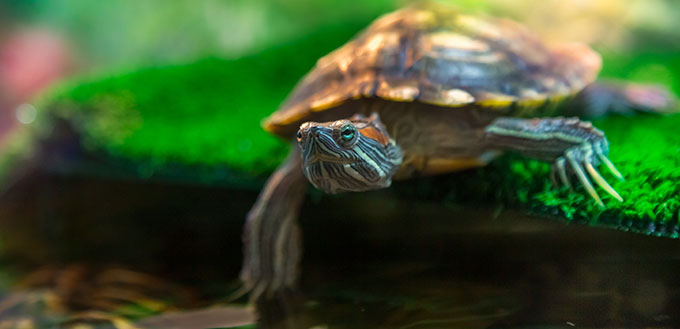
FAQs:
Q: Why are turtles under 4 inches banned in the U.S.?
A: The law banning the sale and possession of these small creatures was created because turtles with shells under 4 inches long are likely to carry salmonella on their skin. The law was passed to protect people from this.
Q: Do Red-Eared Sliders bite?
A: They can and they will if they feel threatened. Red-Eared Slider bites can hurt quite a bit, too, so it’s best to avoid mishandling them or hurting them. Do your research, handle them with care, and know that these little critters won’t just bite you because they can. They only bite when provoked or hurt.
Q: Should I buy a terrapin or pet turtle?
A: As long as you treat them right and you have the correct amount of space for their habitat, owning a pet turtle or terrapin can be a great addition to your home, and a wonderful way to teach a child responsibility.


